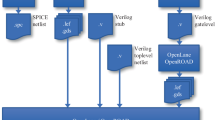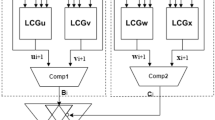Abstract
Physical unclonable function (PUF) makes use of the uncontrollable process variations during the production of IC to generate a unique signature for each IC. It has a wide application in security such as FPGA intellectual property (IP) protection, key generation and digital rights management. Ring oscillator (RO) PUF and Arbiter PUF are the most popular PUFs, but they are not specially designed for FPGA. RO PUF incurs high resource overhead while obtaining less challenge-response pairs, and requires "hard macros" to implement on FPGAs. The arbiter PUF brings low resource overhead, but its structure has big bias when it is mapped on FPGAs. Anderson PUF can address these weaknesses of current Arbiter and RO PUFs implemented on FPGAs. However, it cannot be directly implemented on the new generation 28 nm FPGAs. In order to address these problems, this paper designs and implements a delay-based PUF that uses two LUTs in an SLICEM to implement two 16-bit shift registers of the PUF, 2-to-1 multiplexers in the carry chain to implement the multiplexers of the PUF, and any one of the 8 flip-flops to latch 1-bit PUF signatures. The proposed delay-based PUF is completely realized on 28 nm commercial FPGAs, and the experimental results show its high uniqueness, reliability and reconfigurability. Moreover, we test the impact of aging on it, and the results show that the effect of aging on the proposed PUF is insignificant, with only 6% bit-flips. Finally, the prospects of the proposed PUF in the FPGA binding and volatile key generation are discussed.
Similar content being viewed by others
References
Xia Z, Wang X, Sun X, Wang Q. A secure and dynamic multi-keyword ranked search scheme over encrypted cloud data. IEEE Transactions on Parallel and Distributed Systems. (to be appeared)
Ren Y, Shen J, Wang J, Han J, Lee S. Mutual verifiable provable data auditing in public cloud storage. Journal of Internet Technology, 2015, 16(2): 317–323.
Zhang J, Qu G, Lv Y, Zhou Q. A survey on silicon PUFs and recent advances in ring oscillator PUFs. J. Comput. Sci. Technol., 2014, 29(4): 664–678.
Suh G, Devadas S. Physical unclonable functions for device authentication and secret key generation. In Proc. the 44th DAC, June 2007, pp.9-14.
Zhang J, Lin Y, Lyu Y et al. FPGA IP protection by binding finite state machine to physical unclonable functions. In Proc. the 23rd International Conference on Field Programmable Logic and Applications (FPL), Sept. 2013.
Zhang J, Lin Y, Lyu Y, Qu G. A PUF-FSM binding scheme for FPGA IP protection and Pay-Per-Device licensing. IEEE Transactions on Information Forensics and Security, 2015, 10(6): 1137–1150.
Lim D, Lee J, Gassend B, Suh G E, van Dijk M, Devadas S. Extracting secret keys from integrated circuits. IEEE Trans. Very Large Scale Integr. Syst., 2005, 13(10): 1200-1205.
Asim M, Guajardo J, Kumar S, Tuyls P. Physical Unclonable Functions and their applications to vehicle system security. In Proc. the 69th IEEE Vehicle Technology Conference, April 2009.
Alkabani Y, Koushanfar F. Active control and digital rights management of integrated circuit IP cores. In Proc. International Conference on Compilers, Architectures and Synthesis for Embedded Systems, October 2008, pp. 227–234.
Koushanfar F. Provably secure active IC metering techniques for piracy avoidance and digital rights management. IEEE Trans. Inf. Forensics Secur., 2012, 7(1): 51–63.
Zhang J, Wu Q, Chen J. Research on design method of dynamic partial reconfigurable system. Journal of Software Engineering, 2012, 6(2): 21–30.
Anderson J H. A PUF design for secure FPGA-based embedded systems. In Proc. the 15th ASPDAC, Jan. 2010, pp.1-6.
Pappu R. Physical One-Way Functions. Massachusetts Ave, Cambridge, USA: MIT, 2001.
Maes R, Verbauwhede I. Physically unclonable functions: A study on the state of the art and future research directions. In Towards Hardware-Intrinsic Security, Information Security and Cryptography, Sadeghi A R, Naccache D (eds.), Springer-Verlag, 2010, pp.3-37.
Yin C, Qu G, Zhou Q. Design and implementation of a group-based RO PUF. In Proc. DATE, March 2013, pp.416-421.
Maiti A, Schaumont P. Improved ring oscillator PUF: An FPGA friendly secure primitive. Journal of Cryptology, 2011, 4(2): 375–397.
Morozov S, Maiti A, Schaumont P. An analysis of delay based PUF implementations on FPGA. In Proc. the 6th ARC, March 2010, pp.382-387.
Majzoobi M, Koushanfar F, Potkonjak M. Testing techniques for hardware security. In Proc. ITC, Oct. 2008.
Yu M D, Devadas S. Secure and robust error correction for physical unclonable functions. IEEE Design & Test of Computers, 2010, 27(1): 48–65.
Majzoobi M, Koushanfar F, Potkonjak M. Techniques for design and implementation of secure reconfigurable PUFs. ACM Trans. Reconfigurable Technol. Syst., 2009, 2(1): 5:1-5:33.
Katzenbeisser S, Kocabas U, van der Leest V, Sadeghi A R, Schrijen G J, Wachsmann C. Recyclable PUFs: Logically reconfigurable PUFs. J. Cryptogr. Eng., 2011, 1(3): 177–186.
Zhang J, Lin Y, Qu G. Reconfigurable binding against FPGA replay attacks. ACM Transactions on Design Automation of Electronic Systems (TODAES), 2015, 20(2): 33:1–33:20.
Hammouri G, Dana A, Sunar B. CDs have fingerprints too. In Proc. the 11th CHES, Sept. 2009, pp.348-362.
Kumar S, Guajardo J, Maes R et al. The butterfly PUF: Protecting IP on every FPGA. In Proc. HOST, June 2008, pp.67-70.
Mills A, Vyas S, Patterson M et al. Design and evaluation of a delay-based FPGA physically unclonable function. In Proc. the 30th ICCD, Sept. 2012, pp.143-146.
Zhang J, Lin Y, Wu Q et al. Watermarking FPGA bitfile for intellectual property protection. Radioengineering, 2012, 21(2): 764–771.
Kean T. Cryptographic rights management of FPGA intellectual property cores. In Proc. the ACM/SIGDA Symp. Field-Programmable Gate Arrays (FPGA), Feb. 2002, pp. 113–118.
Zhang J, Lin Y, Che W et al. Efficient verification of IP watermarks in FPGA designs through lookup table content extracting. IEICE Electronics Express, 2012, 9(22): 1735-1741.
Maes R, Schellekens D, Verbauwhede I. A pay-per-use licensing scheme for hardware IP cores in recent SRAMFPGAs. IEEE Transactions on Information Forensics and Security, 2012, 7(1): 98–108.
Li J, Li X, Yang B, Sun X. Segmentation-based image copymove forgery detection scheme. IEEE Transactions on Information Forensics and Security, 2015, 10(3): 507–518.
Xia Z, Wang X, Sun X, Liu Q, Xiong N. Steganalysis of LSB matching using differences between nonadjacent pixels. Multimedia Tools and Applications, 2014, DOI 10.1007/s11042-014-2381-8.
Xia Z, Wang X, Sun X, Wang B. Steganalysis of least significant bit matching using multi-order differences. Security and Communication Networks, 2014, 7(8): 1283–1291.
Fu Z, Sun X, Liu Q, Zhou L, Shu J. Achieving efficient cloud search services: Multi-keyword ranked search over encrypted cloud data supporting parallel computing. IEICE Transactions on Communications, 2015, E98-B(1): 190-200.
Guo P, Wang J, Li B, Lee S. A variable threshold-value authentication architecture for wireless mesh networks. Journal of Internet Technology, 2014, 15(6): 929–936.
Paral Z, Devadas S. Reliable and efficient PUF-based key generation using pattern matching. In Proc. the IEEE Int. Symp. Hardware-Oriented Security and Trust (HOST), May 2011, pp.128-133.
Author information
Authors and Affiliations
Corresponding author
Additional information
This work was supported in part by the National Science Foundation for Distinguished Young Scholars of China under Grant No. 61225012, the National Natural Science Foundation of China under Grant Nos. 61572123, 61501525, 61402162, 61232016, and U1405254, Hunan Province Science and Technology Project under Grant No. 2014RS4033, and the PAPD fund.
Rights and permissions
About this article
Cite this article
Zhang, JL., Wu, Q., Ding, YP. et al. Techniques for Design and Implementation of an FPGA-Specific Physical Unclonable Function. J. Comput. Sci. Technol. 31, 124–136 (2016). https://doi.org/10.1007/s11390-016-1616-8
Received:
Revised:
Published:
Issue Date:
DOI: https://doi.org/10.1007/s11390-016-1616-8




